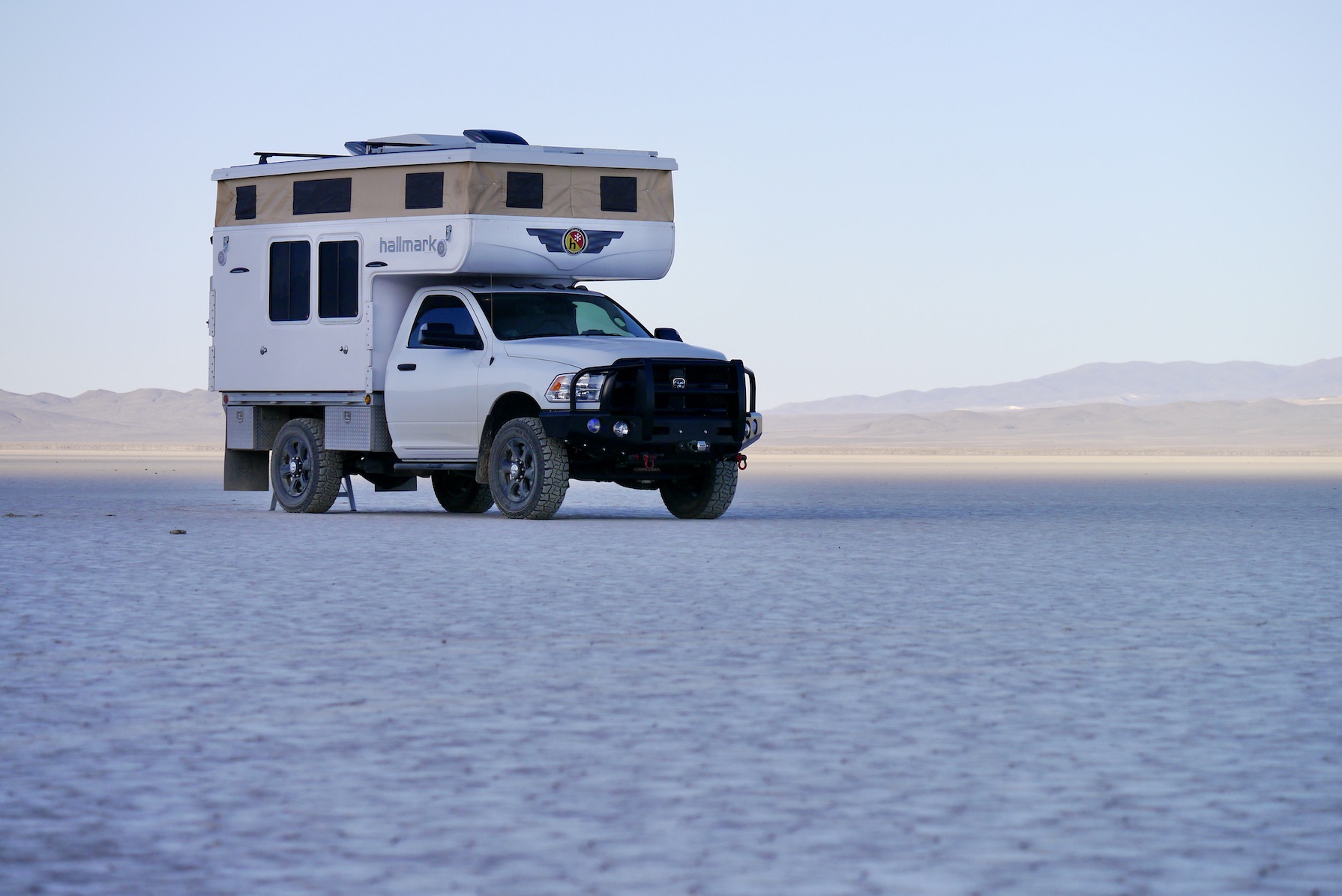Introducing Tesche Tire USA
Tesche Tire is a Chinese company founded in Hong Kong in 2013, with additional development, manufacturing, testing, distribution, and marketing offices in California, USA, and Bangkok, Thailand. In early 2025, Tesche (pronounced tesh) started importing tires into the USA, establishing distributor and dealer networks with the goal of becoming a high-quality yet budget-priced brand in the competitive American market. Tesche has a few light-truck designs for the Turbo Diesel Register audience, including the tread that caught my eye at the 2024 SEMA Show.
Ridge Blade X/RT
The Tesche Ridge Blade X/RT (Extreme Rugged Terrain) is a high-void, four-rib tire advertised as designed and engineered in the USA, made in Thailand. Like most similar designs, the upper sidewall has thick tread for additional traction and to prevent punctures. One side has raised black lettering with an inset tread pattern, the other has thick, solid raised black letters. They have 3-ply sidewalls and many of the blocks are linked to prevent tread squirm and reduce wear. There are stone and mud ejectors, a little siping, and some lugs are conveniently marked with 75%, 50%, and 25% to show the tread depth remaining.
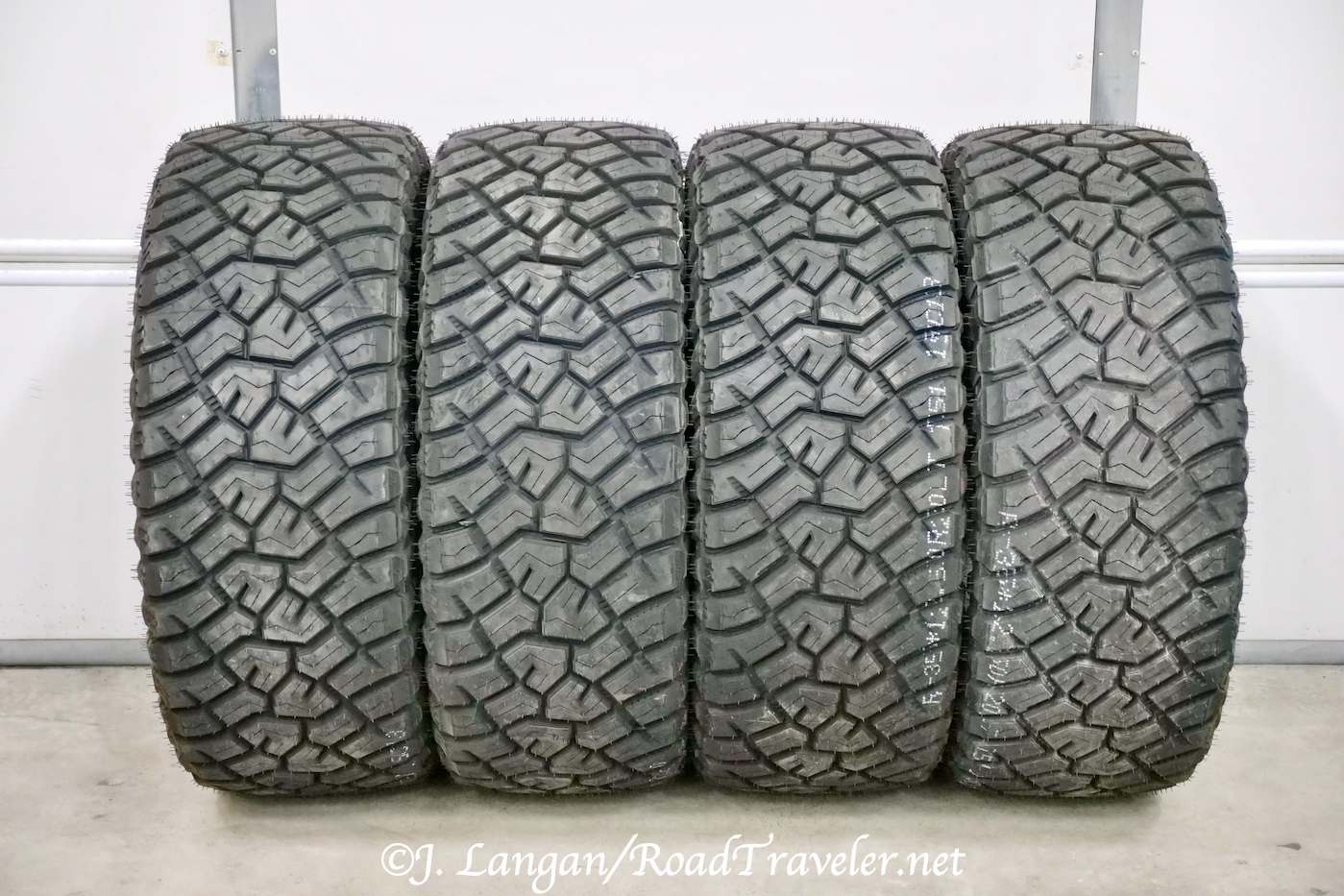


Why A Rugged Terrain
Whether you call them rugged terrains (the newest, most popular moniker), a commercial traction, aggressive all-terrain, or hybrid design, any relatively high-void and stoutly-constructed traction tire that’s quieter than a mudder probably qualifies. Think bigger tread blocks and more space between the lugs than the ever-popular BF Goodrich All-Terrain. Of course, there are always trade-offs. Rugged terrains will be louder than highway or all-seasons, potentially have a rougher ride because of their heavy-duty construction and/or larger lugs slapping the tarmac, and generally won’t last as long.
Sizes And Specifications
Tesche’s brochure offers dozens of X/RT sizes for wheels from 15 inches all the way up to 28 inches in diameter. The majority are for the most popular 17-inch, 18-inch, and 20-inch sizes, and all are listed as having 18/32-inch of tread (keep reading). From the limited options available from the initial shipping containers hitting the Southern California docks in early 2025, I chose the 35X12.50R20LT for this evaluation.
In this 35-inch size, the X/RT is 34.57-inches tall, 12.28-inches wide, with the aforementioned 18/32-inch depth, while touting a load-range-F, 12-ply rating. Light-truck load-range-F tires in this size should have a load index of 125 and be rated to handle 3,640 pounds at 80 psi. However, based on the sidewalls the set I received only have a 121 load index, which according to Tire and Rim Association standards are rated for just 3,195 pounds at 80 psi.

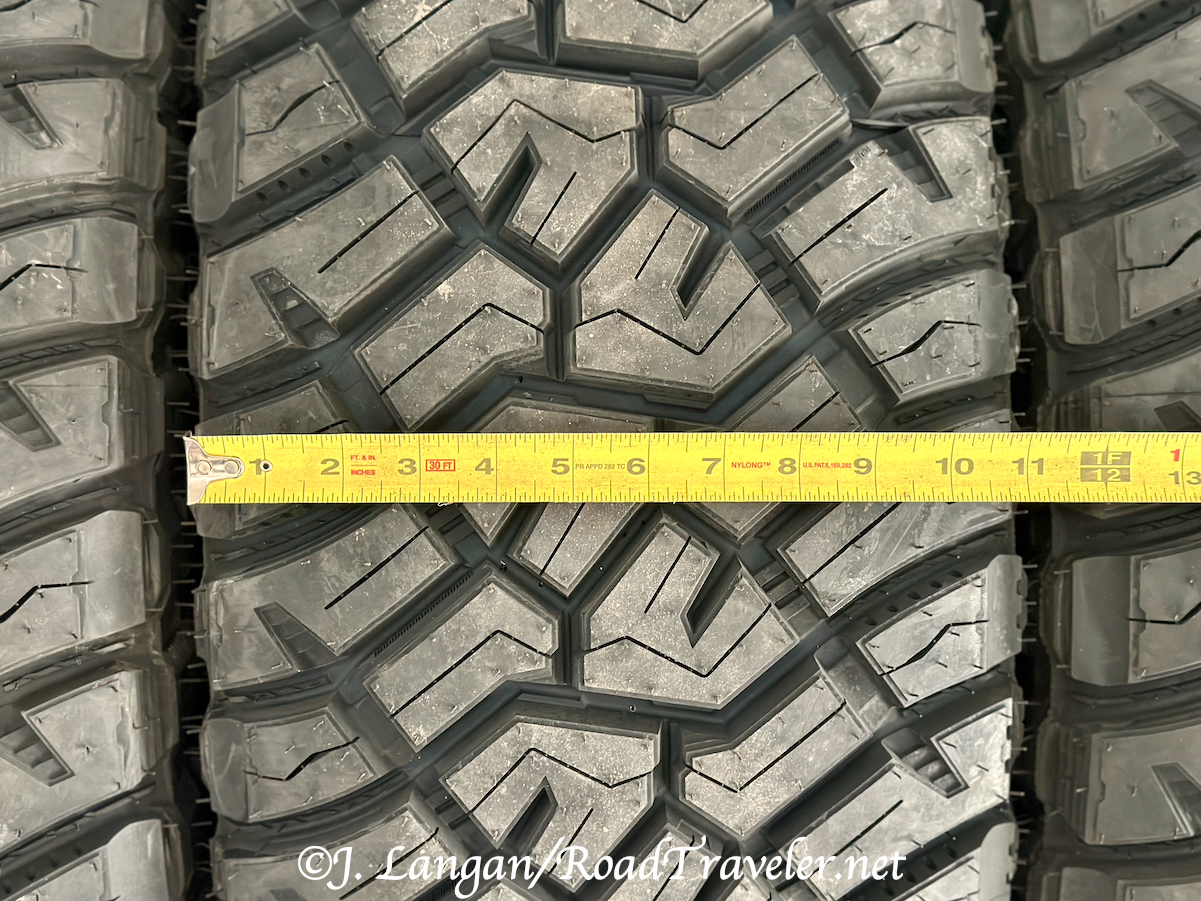
When I asked Tesche about these inconsistencies they assured me that these made-in-Thailand X/RT actually meet the load-range-F specifications, and the discrepancies were due to importation and tariff challenges. It is possible that many consumers would not catch this, or may not care when buying less expensive rubber. However, I informed them that some enthusiast definitely would care, and that all the published ratings and sidewall data should be consistent and accurate.

Additionally, although the tread depth is listed as 18/32”, I measured approximately 17.5/32”. Tesche stated the advertised depth was a conversion from 14 mm, approximately 17.5/32”, and they rounded up to 18/32”. My suggestion was that they be as precise as possible, and gave them an example of a specific Toyo C/T size that has an advertised depth of 18.4/32”, which is accurate. Tesche deserves much credit and respect for being genuinely receptive to my input and critique.

Siping depth is quite shallow, about 6/32”, which means that when the tread has worn down to about 11/32” the siping will disappear. Plenty of designs do not have full-depth siping, or any siping at all if they are a high-void mudder. However, many rugged terrains do have much deeper sipes, which is generally preferred because the additional gripping edges can significantly increase traction on slippery surfaces. The location, depth, or shape of sipes can increase the odds of rubber being cut or torn more easily, so as always there are tradeoffs.

To round out my constructive criticism, like other overseas companies Tesche’s promotional material translations leave much to be desired. Their slogans, naming, and phrasing makes for interesting reading. These criticisms aside, I do like the Ridge Blade X/RT, their quality and overall performance has been impressive… dare I say as good as most known brands!
Sidebar – Less Expensive Offshore Tires Found At SEMA
In addition to the numerous mainstream tire companies familiar to enthusiasts, there are always a plethora of unknown overseas manufacturers at the SEMA Show. Many offer huge commercial, agricultural, or mining application products, but there are plenty with light-truck offerings as well.
There are always a few interesting tread patterns that catch my eye, some are blatant copies, but others are different and interesting, and one would think it would be easy for a journalist to strike up a conversation to potentially source a set for an article. However, my experience has been exactly the opposite.
Either there is such a language barrier that just initiating a conversation is a significant hurdle, or the company is not really trying to have their products reviewed for the North American consumer market. That may sound strange but SEMA is less about journalists and more about potential importers and buyers. When I walked up to the Tesche booth they became the first enthusiastically engaging offshore tire manufacturer I have spoken with.
Will, a Chinese gentleman with a good command of English, was excited when I showed him a copy of my Still Plays With Trucks column in Turbo Diesel Register 126, which contained a detailed evaluation of the LT255/85R17 Mickey Thompson Baja A/T. He said “that is exactly the type of review we want”, as they were just preparing to enter the US market in 2025. Tesche promised me a set as soon as they hit the Southern California docks, and they followed through in January 2025.
—————–
Snag Getting Them Mounted
Most 12.5-inch-wide flotation sizes are supposed to be mounted on rims that are at least 8.5-inches wide, so stock 8-inch wheels are technically too narrow. Tesche lists the X/RT in a 35×11.50R20 that I would have preferred, and also would fit perfectly on an 8-inch rim, but they were not yet available. Buying new wheels solely for this evaluation was a deal-breaker, so just like for previous articles I chose to squeeze them onto a set of 8-inch-wide OEM rims.
Many shops won’t notice rims that are a little too narrow, or they might not care. However, Discount Tire is a stickler and refused to mount and balance the 35×12.50R20 on 8-inch rims. Another store just down the street didn’t balk, and there was a silver lining to this minor hurdle.
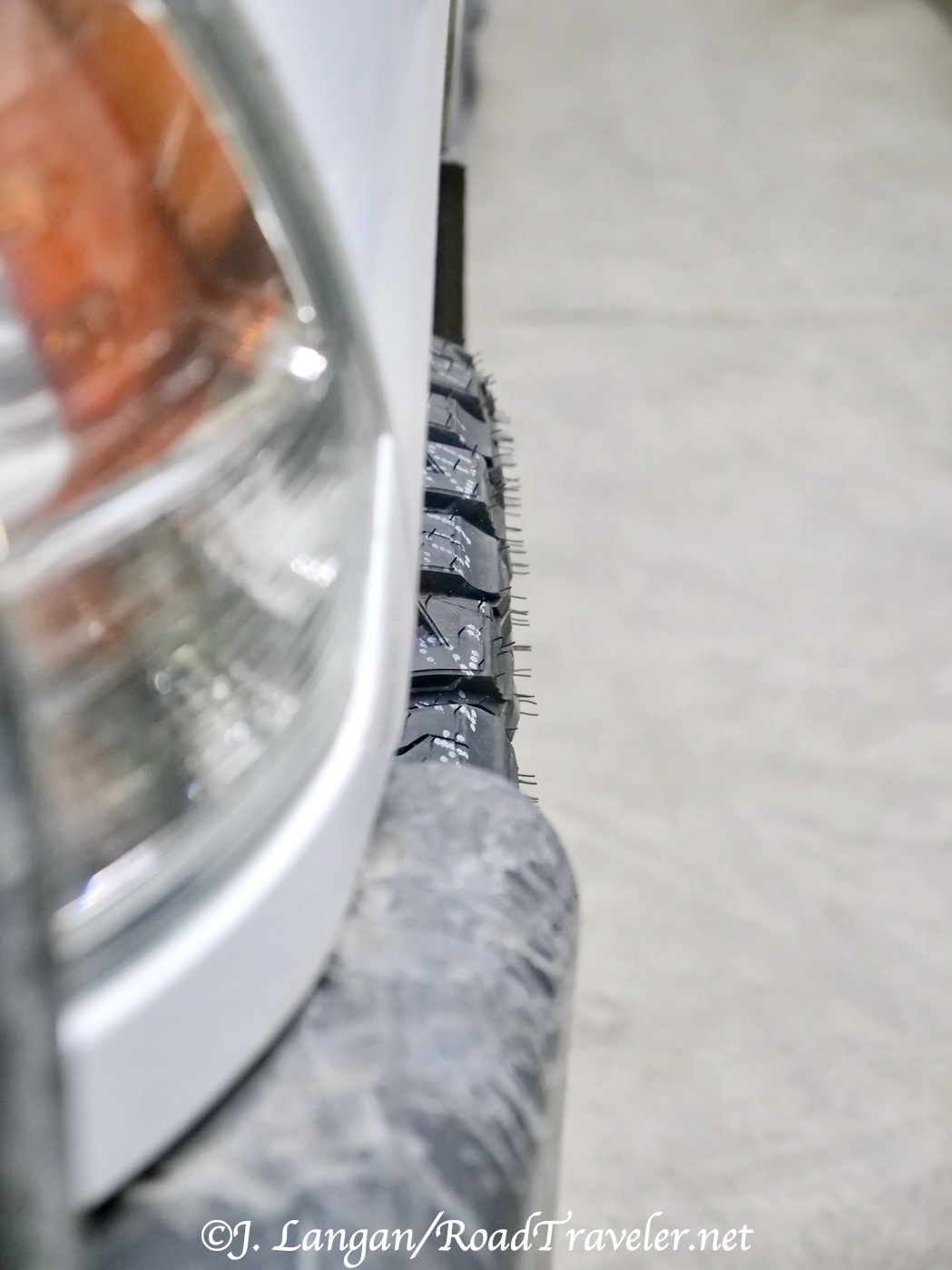
This shop was not willing to use the static, single plane balancing method that I generally prefer, which puts less weight on the wheels. For 35-inch and taller rubber they insist on using the dynamic, dual plane method (they are likely trying to avoid customer complaints and comebacks). Dynamic balancing is theoretically the best method because it corrects for both vertical and horizontal imbalances, but if done poorly an excessive amount of weight can be added. Dynamically balancing the X/RT showed how impressively little weight was needed; the quality and trueness of this set might not have been so obvious if static balancing had been used. Unfortunately, I was not able to get the road force information, which can be another helpful metric of overall quality. However, my on-truck assessment of my set of Tesche X/RT tells me they do not have excessive road force.
Impressive Balancing Results
When it comes to balancing a tire mounted on a wheel, often it’s the wheel that is more out of balance than the tire, so much of the weight needed is because of the wheel. Larger rims are heavier, and therefore often require more weight than a smaller rims.
The 67-pound X/RT tires were mounted on 40-pound OEM aluminum Ram 20″ wheels. All four required minimal weight to balance, the most being just 5.25 ounces. The average for all four 107-pound assemblies was 4.4 ounces; impressive! This caused me to question if the technician had balanced them properly, but my concern disappeared after rolling down the highway at speed.
Tire Number, Weight Outer, Weight Inner
#1) 4.5 oz. / None
#2) 2.75 oz. / 1.00 oz.
#3) 3.50 oz. / 0.75 oz.
#4) 4.25 oz. / 1.00 oz.


Tracking And Handling
With 55 psi in the fronts and 35 psi in the rears steering response was good and there was noticeably less body roll. Ride quality was slightly firmer than the bigger tires I removed due to the 0.8-inch shorter diameter. (For a given tire diameter, taller wheels yield shorter sidewalls, which reduces sidewall flex, roll, and typically improves responsiveness at the expense of a firmer ride.) Centramatic balancers certainly help, but the X/RT were obviously balanced well, as they remained smooth well above the limit on Interstate 80 in rural Nevada.
Straight line tracking and stability can be greatly affected by the surface, road crown, vehicle alignment settings, and modifications. That disclaimer aside, tracking with the X/RT was phenomenal on my 2014 Ram. My preferred baseline standard is to have at least several seconds (6 – 10) of look mom no hands driving on a smooth, flat, and straight roadway before needing to steer my drifting truck back to the center of my lane. The Ridge Blade easily surpassed that standard multiple times, including one run that lasted 25 seconds!

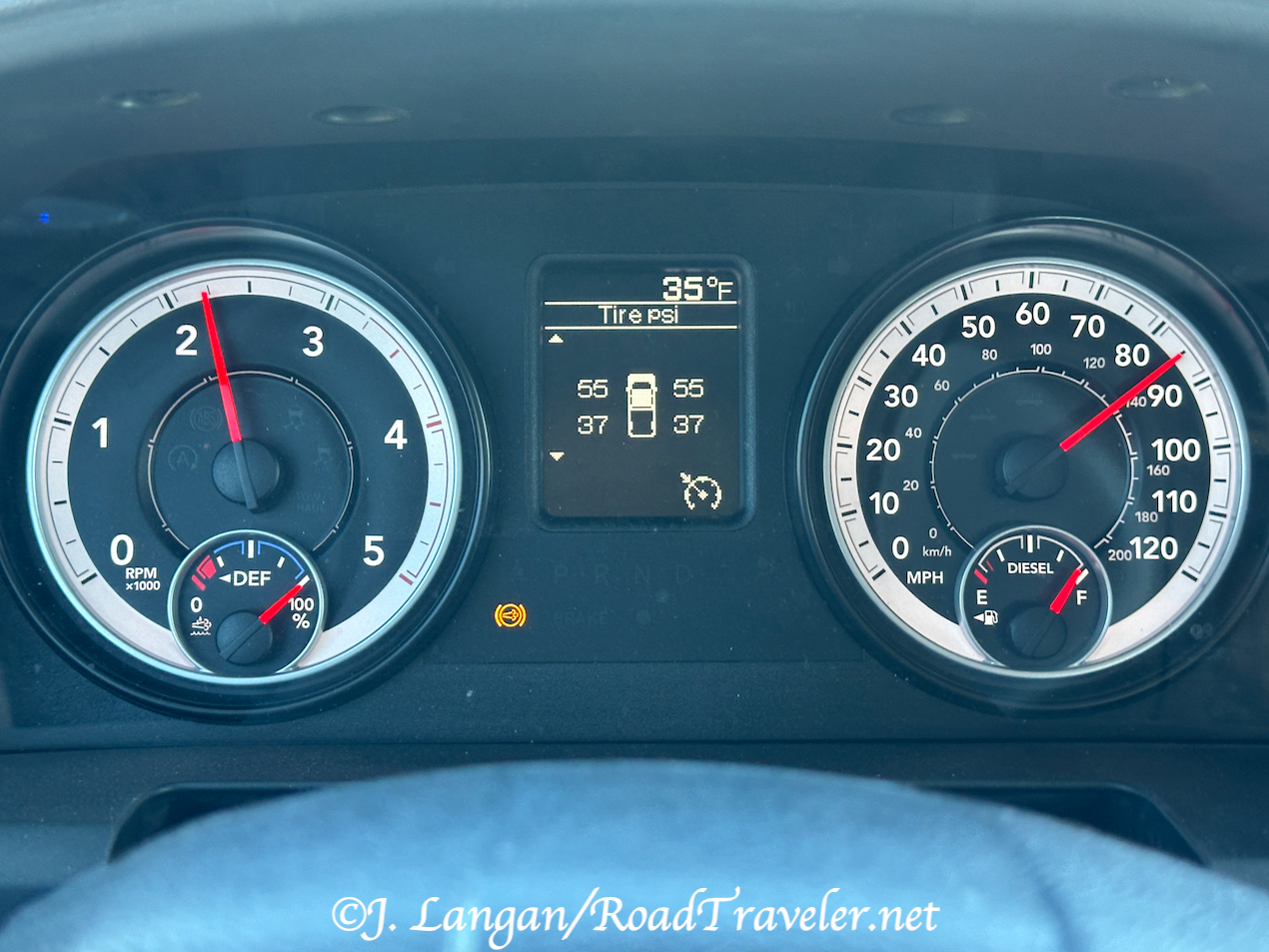
Overall Traction And Performance
Like all the tires I evaluate, the X/RT saw lots fast freeway driving, local commuting, a decent amount of snow/slush, very little mud (winter slush can be similar, and they cleaned themselves appropriately), hundreds of fast and slow 4WD off-pavement miles, and a bit of light trailer towing. They seemed to perform well on all surfaces and I never felt they lacked grip or were sub par. All designs will pickup rocks when off-pavement, the size of which directly correlates to the space between the lugs and the road surface, usually throwing them once back on-pavement at highway speeds. The Ridge Blade X/RT didn’t seem to pickup, hold, or throw as many stones as some competitors. Surprisingly, I could not find any cutting, chipping, or tearing of the tread or sidewalls from the off-road driving.
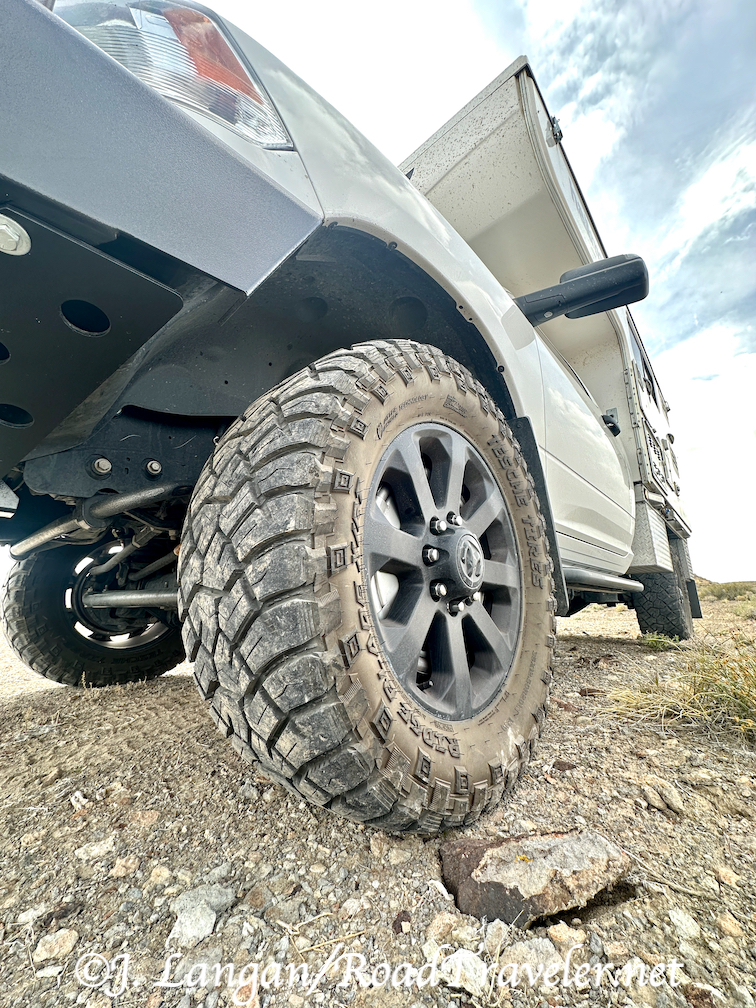

Wear Data
In January 2025, the Ridge Blade X/RT were mounted on my 2014 crew cab 2500, and after two rotations I had quickly logged 5,000 miles. They were performing so well and consistently under that heavily-armored (9,000-lb. wet/empty), manual transmission Cummins Turbo Diesel, that I decided to give them a chance to prove themselves working even harder during a spring road trip under my 2017 regular cab with Hallmark flatbed camper.
This added another 1,850 miles under that RV, which typically has about 5,500-pounds on the front axle and 6,500-pounds on the rear. The X/RT performed just as well under the camper as on my crew cab. After that trip they were swapped back onto the 2014 to reach 7,000 miles of total use.
Quality aftermarket tires on my trucks often yield approximately 2,000 to 2,200 miles for each thirty-second of rubber, so better than that is noteworthy. Accurately measuring down to 1/32” can be challenging, however, two gauges indicated the X/RT were down just 2.5/32”. That equals an exceptional 2,800 miles per 1/32” of tread! Not the best I have ever seen, but close and definitely outstanding.
Even if I am pessimistic and say that my measurements are off by 0.5/32” (1/64”), and they wore 3/32”, that would be 2,300 miles per 1/32”, and still above average.
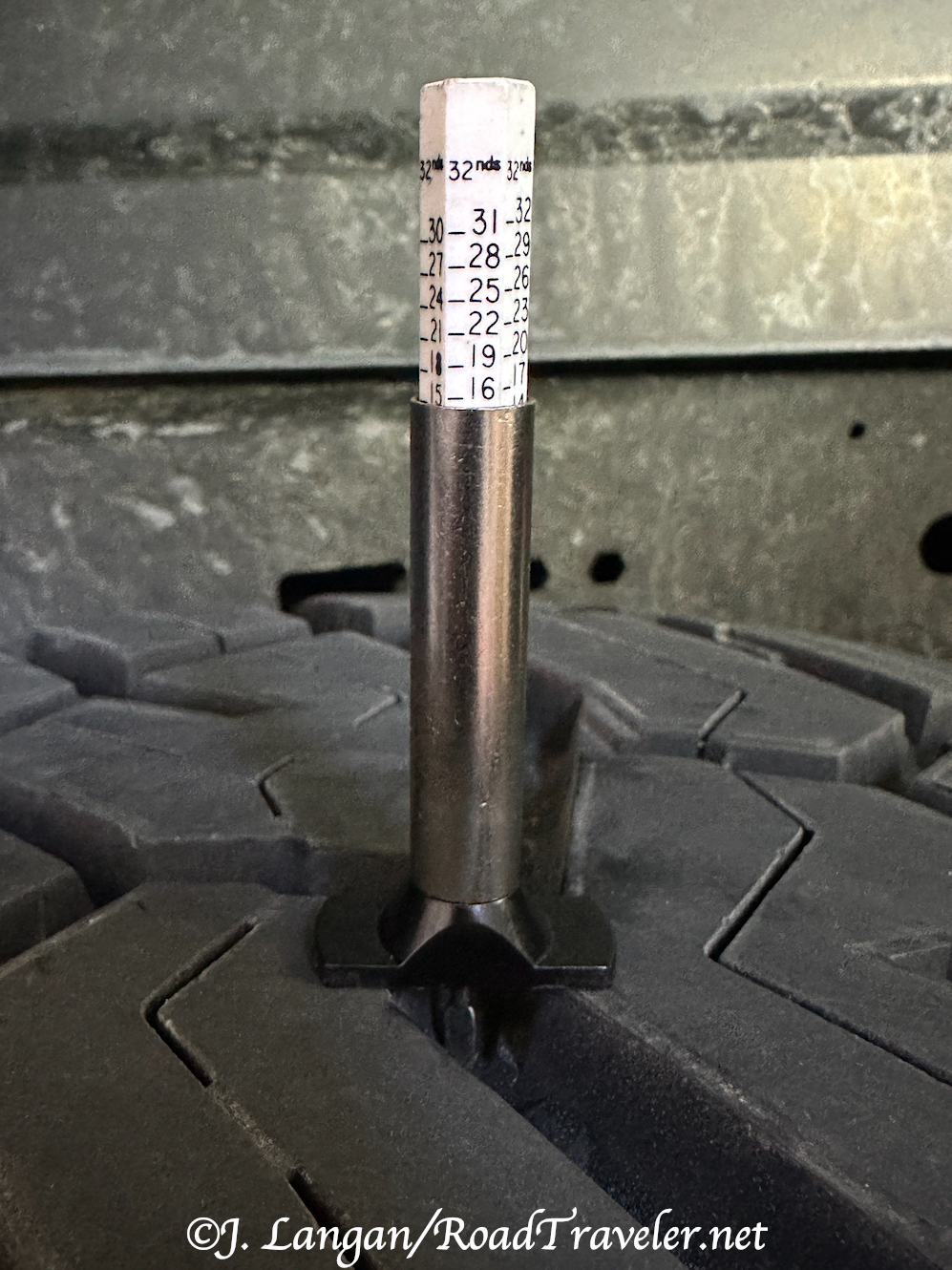
Sidebar-Tire Reviews Will Always Be Popular
Why are tires such a popular topic for both enthusiasts and regular consumers, maybe more popular than oil? From my perspective the answer is simple, and like most things it boils down to our wallets. Although modern tires are generally well-made, high-quality, a good value, and can last much longer than designs from 30 to 50 years ago, they are still a fairly expensive recurring maintenance cost. How about a real-world comparison?
Changing the engine oil in a modern Cummins Turbo Diesel at the maximum recommended 15,000-mile interval should cost about $100 for the filter and three gallons of premium oil if we do it ourselves. Do that three times to cover 45,000 miles and we’ve spent $300. Let’s use that same 45,000 miles as a theoretical average for putting new rubber on a heavy-duty pickup.
Depending on the size, manufacturer, and retailer, many modern pickup tires can cost approximately $300 each, including the stock LT275/70R18E. Four at $300, plus balancing (mounting is generally included), and my local 8.26% sales tax would total $1,400. That’s 4.6 times more than the cost of oil changes to cover the same 45,000 miles. (This reinforces the mantra that oil is in fact relatively inexpensive, and that we should change it at optimal intervals, without being penny wise and pound foolish.) Fourteen-hundred dollars is an expenditure that requires consideration, and if you like taller sizes (tires or wheels) you will likely pay much more.
Just before my article deadline my friend Tony from Colorado called for a new rubber recommendation, commenting that “tires are a much bigger investment these days”. In 2017, Tony and I trekked up to the Canadian Arctic to drive the infamous ice road before the new year-round replacement was completed. Before that Arctic adventure Tony had purchased a set of Toyo C/T based on my recommendation. Our conversation was long, detailed, and multifaceted, and he was extremely close to choosing the C/T again. That was until I added that the Yokohama Geolander A/T XD I had bought recently appeared to have similar traction and wear characteristics to the C/T, while being slightly quieter at higher freeway speeds. Less road noise was appealing so Tony decided to try the A/T XD, and he is happy with that decision.
——————-
How Much Road Noise?
Evaluated through my ears inside my Fourth Generation Tradesman, the noise was about what you’d expect when you look at the fairly aggressive design. The X/RT is not the quietest in the segment — that title currently goes to the Mickey Thompson Baja Boss A/T, which does have a tighter tread pattern — nor is the X/RT likely the loudest.
In back-to-back testing over the same roadways the Tesche X/RT have a similar overall volume to the Toyo C/T (still love and have a set), or the Cooper Discoverer S/T MAXX (run them on our 4Runner), however, the X/RT have a slightly higher pitch tone. The Ridge Blade X/RT also have a bit more void in the center, which has a large effect on perceived noise.
Like most designs the Ridge Blade X/RT is loudest on concrete freeway, and the volume of the singing increases with speed, particularly above 75 mph. It’s also important to remember that wider sizes, that put more rubber on the ground, are generally louder than narrower sizes.
Modern traction designs are relatively tame, but if you really want quiet get a highway rib tread. If you want the best traction in sloppy conditions and don’t care about the noise, then get a mudder. Anything between those two extremes will have traction or noise compromises, and perceptions and opinions are always subjective. Filtered through my less than perfect hearing, the X/RT are slightly loud for a modern rugged terrain, but they also offer more void than some competitors. If you are sensitive to road noise the X/RT might not be right for you (or maybe any rugged terrain). If you want or need the traction and don’t mind them singing a little while you’re rockin’ down the highway, they are a good choice.
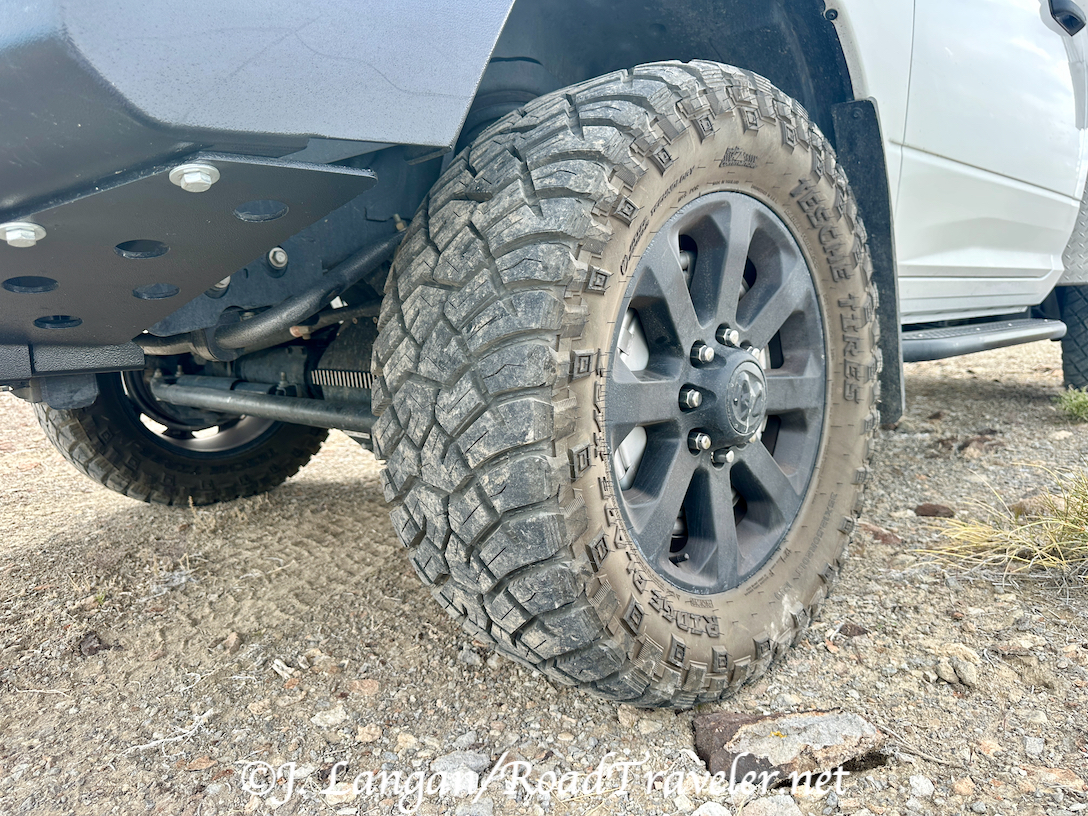
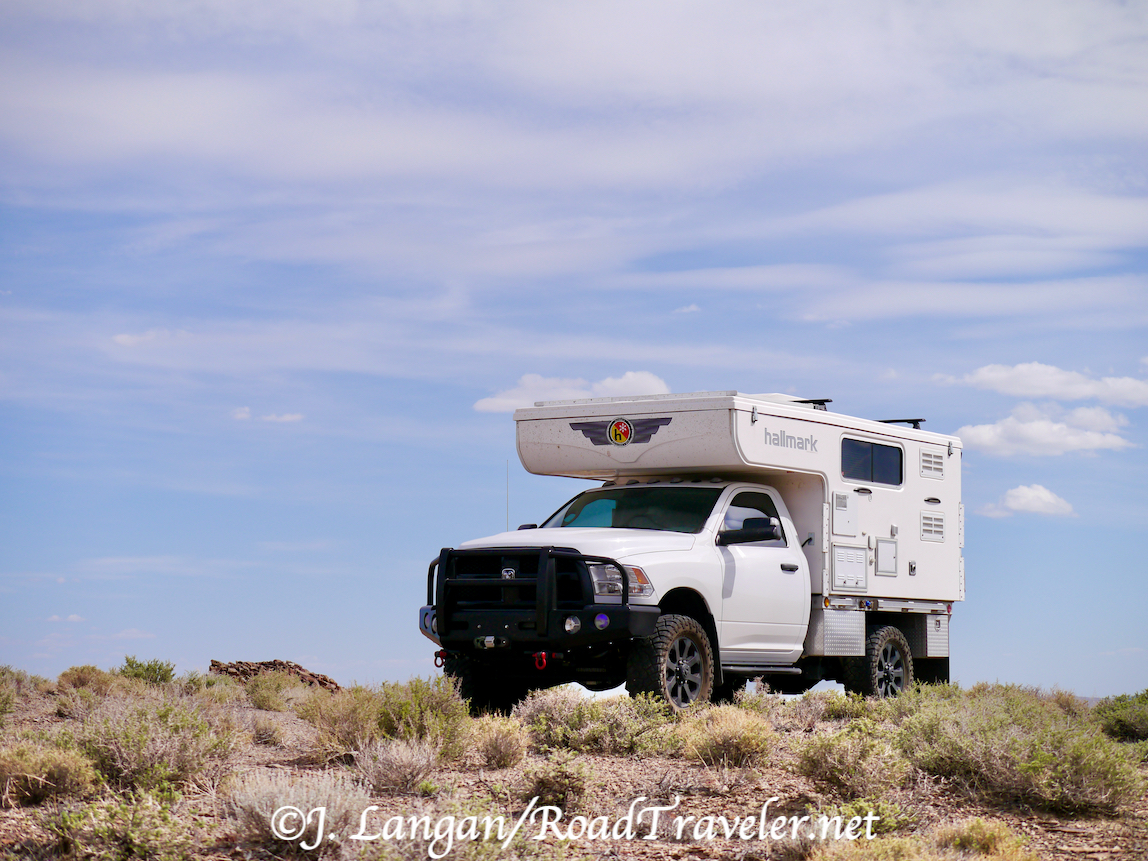
Good Value
Many major purchases boil down to the bottom line… how much do they cost. Tesche is so new to the US market that I actually delayed this review a few months because retail pricing was not yet available.
As of August 2025, the minimum advertised price (MAP) for the 35×12.50R20 Ridge Blade X/RT I tested was $368 each. When you consider that the street price can be substantially less than MAP, they immediately become even more attractive.
Online vendor PriorityTire.com had the 35×12.50R20 X/RT on their website for $304. Tires-Easy.com had them for $287 after adding FET (Federal excise tax), and shipping was free from both outlets. Tires-Easy.com also had the late-model heavy-duty Ram stock size, the LT275/70R18, for a mere $199 (no FET), which is much less than average for that size.
Of course my sample size was just one set, but the four I ran exhibited no flaws or quirks, and performed as well as any mainstream brand in recent memory. Tesche is definitely a good option for the price conscious consumer.
Tell ‘em you saw it on RoadTraveler.net!
Copyright J. Langan/RoadTraveler. All Rights Reserved
This article was also published in the Turbo Diesel Register magazine.
Resource:
Tesche Tire USA: www.teschetire.com
